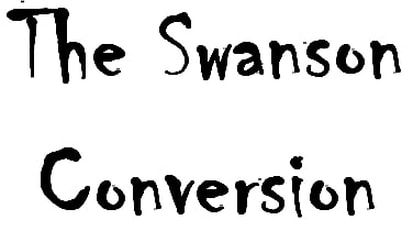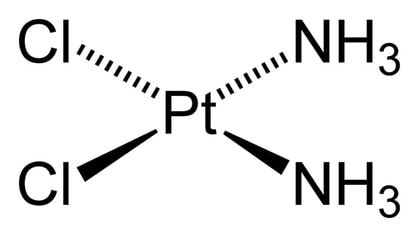 On April 29 of 2017, I posted in this blog about a Wikipedia mystery. The mystery concerned a chemical reaction linking the processes of glycolysis, where sugars are converted to a metabolite called pyruvate, and the Krebs Cycle, where pyruvate is oxidized to carbon dioxide and water, producing the majority of the energy that most living things use. This linkage involves a reaction which contains a step where a molecule of carbon dioxide is removed from pyruvate in a process called “decarboxylation”. I found that this pyruvate decarboxylation step was named the “Swanson Conversion” in a Wikipedia page dealing with this subject. The problem was that nowhere in the biochemical literature was there any mention of this metabolic step using that name. In another post, I wrote about the solution to this mystery. Andreas Kolbe, who posts on Twitter under the handle “Wikiland”, contacted me to let me know that he had found the perpetrator of the hoax. Apparently a high school teacher named Swanson referred to this particular metabolic step in his classes as the Swanson conversion to help his students learn its importance in the whole process. One of his students then decided to edit a Wikipedia article naming this reaction “The Swanson Conversion”. When the teacher found out about this edit, rather than notify Wikipedia, he decided to use this occurrence as an experiment to see how long it would be before it got detected. He also presented this as an example to his students of how you have to be cautious when using Wikipedia.
According to Wikipedia, the hoax remained in the Wikipedia page dealing with pyruvate decarboxylation for 6 years and 6 ½ months, and they quote one of my posts to explain the edit removing the term “Swanson Conversion” from the page. While this hoax holds the record for the longest that a chemistry/biochemistry hoax has survived in Wikipedia so far, it is by no means the longest hoax. There are 85 detected hoaxes in Wikipedia that have lasted longer than the Swanson Conversion, with the longest hoax (the claim that “Vivarem” is a Sanskrit word) surviving 12 years and 9 months before being detected. Wikipedia hoaxes have made their way into newspapers and academic publications, only to then be quoted by Wikipedia in support of the hoax in a process that has been humorously termed “citogenesis” or more formally “circular reporting”. Because of this, I was interested in investigating whether this hoax had made its way into mainstream science. In my previous post, I mentioned that I had found at least one scientific article that included the hoax. A Single Regulator Mediates Strategic Switching between Attachment/Spread and Growth/Virulence in the Plant Pathogen Ralstonia solanacearum by Khokhani and coworkers was published in the journal mBio in 2017. The mention appears in the “Results” section of the article: “The low-cell-density-mimicking strain also upregulated genes involved in fatty acid metabolism, such as the Swanson conversion of pyruvate to acetyl-coenzyme A (acetyl-CoA), acyl-CoA dehydrogenases and acetyltransferases, and the trifunctional enoyl-CoA hydratase/ delta3-cis-delta2-trans-enoyl-CoA isomerase/3-hydroxyacyl-CoA dehydrogenase that catalyzes the -oxidation of fatty acids (Fig. 3).” Since then, I have found 2 additional articles that contain the hoax. Understanding the microbial basis of body odor in pre-pubescent children and teenagers by Lam and coworkers published in the Journal Microbiome in 2018. The mention also appears in the “Results” section of the article. “In an independent pathway, enzymes involved in oxidative degradation of pyruvate aliphatic carboxylates to acetyl-CoA (Swanson Conversion) in a process that is key to the production of acetic acid and sour odor were found to be malodor-associated in S. epidermidis (Fig. 3d; e.g., pyruvate dehydrogenase (EC:1.2.4.1)).” And Dissecting the transcriptional networks underlying the gibberellin response in Nicotiana tabacum by Manoharlal and coworkers published in the journal Biologia Plantarum in 2018. The mention appears in the “Results and Discussion” section of the article (note: this article is not freely available online). “A pyruvate dehydrogenase complex (a PDHC-E3 subunit, dihydrolipoyl dehydrogenase) catalyzes the conversion of pyruvate to acetyl-CoA by pyruvate decarboxylation (Swanson conversion), thereby paving the entry of pyruvate into the TCA cycle, was observed to be significantly down-regulated (RFC = -3.81).” Apart from these 3 articles, I also found 2 patent applications that include the hoax. Methods of selecting subjects for treatment with metabolic modulators by David Kolb filed in 2017 “The pyruvate dehydrogenase complex facilitates conversion of pyruvate into acetyl-CoA by pyruvate decarboxylation (Swanson Conversion) thus linking the glycolysis metabolic pathway to the citric acid cycle.” And Pharmaceutical Compositions Affecting Bioenergetic Processes in a Eukaryotic Biological System and Methods of Treatment by James Sheehan filed in 2016 “Acetyl-CoA is produced during cellular respiration during the Swanson Conversion, which takes place in the mitochondria of eukaryotic bioenergetic systems.” The hoax has also made it into the webpage of at least one corporation. The company BOC Sciences, which sells chemical and biological products, includes the hoax in a webpage describing one of its products. The pyruvate dehydrogenase complex contributes to transforming pyruvate into acetyl-CoA by a process called pyruvate decarboxylation (Swanson Conversion). As you can see, these descriptions mention the Swanson Conversion as if it were established science without even quoting a reference to justify the name. If this hoax had not been detected and removed from Wikipedia, some of these references could have been cited in support of the hoax closing the circular reporting (citogenesis) loop. Another interesting aspect is that although the hoax was introduced in 2010, the earliest mention I have found so far of the hoax in the mainstream scientific literature is the patent filing from 2016. This may indicate that several years are required before a Wikipedia hoax enters the scientific literature, or that during this time frame scientists acquired the mentality that it’s acceptable to use Wikipedia as a source, or that the hoax was taught to science students as fact (see below). There is also the question of how the Swanson Conversion hoax made its way into mainstream science. I can imagine two ways: 1) When scientists without a very in depth knowledge of the topic (and no one can be an expert in everything) took the information directly from Wikipedia or from a source that mirrors or quotes Wikipedia. Although this mistake is not excusable, it is understandable. The technical literature seldom contains readily accessible repositories of the most basic information presented in a straightforward way for every topic. The temptation is always there to save time and accept the abbreviated information provided by Wikipedia or related sites without consulting additional literature. Or 2) When students who have been taught the hoax advance in a career in the chemical or biochemical sciences and are asked to contribute to write parts of scientific articles or other documents. These students may go back to check their old study notes and end up perpetuating the hoax. In my first post about the Swanson Conversion hoax, I mentioned that several websites featuring the hoax provide study support for students in the form of study sets, lectures, flash cards, mock exams, and even videos. Many students were and are still being educated with the notion that this hoax is true. As you can see Mr. Swanson’s high school experiment is still ongoing, and it has made the transition from a mere Wikipedia entry into mainstream science. Now that the hoax has been exposed and deleted from Wikipedia, will that stop its spread? How far will the Swanson Conversion infiltrate the scientific establishment? How long will it go? Stay tuned and I will keep you posted!
0 Comments
 The average person considering taking medicines or undergoing a medical procedure is exposed to both a best-case scenario advertising by those who want to sell their product and make money, and a daunting worst case scenario list of possible risks required by law to protect consumers. You have probably seen some of those drug advertisements on TV where people have a disease, they take the advertised drug, and their problems are reduced or go away. The advertisement features actors portraying patients once again able to go about their daily activities with smiles on their faces having rid themselves of their afflictions. But in the background of these advertisements a voice comes along (with captions) warning would be users of the drug about all the possible risks of taking the drug. I recently watched one of those commercials for an FDA-approved drug and made a list of all the risks involved in taking this drug. These included: Allergic reactions, rash, hives, blisters, muscle pains, fever, blurry vision, trouble breathing, dizziness, sleepiness, changes in behavior, worsening mood, depression, and suicidal thoughts. After reading this list, some people may wonder who in their right mind would take this drug and expose themselves to all these risks! It is really a stark contrast between seeing all those handsome actors portraying smiling patients relieved of their maladies, and the voice warning consumers of these ghastly possible outcomes and side effects. What is a person to do with these schizoid scenarios? The public has to understand two things about drugs and medical procedures. 1) These lists of risks are comprehensive enumerations of every possible negative outcome that can happen. These lists do not offer any detail as to the percentage of patients that experienced these negative outcomes. Was it 0.5% of patients that experienced these bad things, or was it 50%? Additionally, these risks may be more prevalent in a subclass of patients (say those with some pre-existing conditions) and may not affect all patients equally. Before taking the drug, or having the procedure, prospective patients need to find out what the actual frequency of side effects is, their intensity, and what type of patients are more prone to having them. 2) Even if a drug or a procedure has sizable risks, these risks may be justified if the patient considers that the chance that the drug, or the procedure, has in treating the disease is a better tradeoff than living with the disease or dying from it. There are drugs with terrible side effects that may even kill, which are nevertheless applied to patients who would otherwise die. On the other hand, a person afflicted with a milder disease may forgo taking a drug with nasty side effects, and choose instead to live with the disease and manage its symptoms by other means. Essentially, it all boils down to asking what do you want, and what risks are you willing to accept in exchange for an opportunity at having what you want. Let me give you an example. Consider the following procedure that is carried out in the United States. What are the risks of this procedure? This procedure may produce feelings of weakness, tiredness, dizziness, and faintness, with accompanying paleness, and shortness of breath. This procedure may also trigger depression, producing irritability, and an intense sadness with feelings of helplessness and suicidal thoughts. Other possible complications in the procedure are abdominal or shoulder pains, bleeding, high blood sugar, hypertension, infections, blood clots, cardiac malfunction, and death. The occurrence of extreme thirst, hunger or fatigue, or alternatively persistent nausea and vomiting, weight loss, reduced appetite, and dehydration has also been documented. On the average, out of 100,000 people who go through this procedure in the United States about 28 die. With all these risks, would you subject yourself to this procedure? Would you want your loved ones to subject themselves to this procedure? Well, let me give you another piece of information. This “procedure” is called “pregnancy”. Yes, that list of risks above (which is not comprehensive) is a real list of everything that can go wrong during a pregnancy. Of course, these risks are not distributed equally among all women. Obese, older, or younger women, or women who had hypertension, diabetes, and chronic heart disease when they became pregnant have higher risks. White women have a lower risk than black women or women from other races. However, despite these risks, most women choose to become pregnant. Clearly in the mind of these women and their partners the end result, having a baby, is worth these risks. Going back to drugs and medical procedures, the idea is the same. Drugs and medical procedures are not perfect. They all have side effects and potential complications, and the frequency and severity of these complications may depend on the patient or the type of medical care provided. Prospective patients have to educate themselves and seek advice, gauge their condition, determine the risks, weigh them against the possible outcomes, and decide what to do. The pills image is in the public domain.  Nazi Doctors trial in Nuremberg 1946–1947 Nazi Doctors trial in Nuremberg 1946–1947 Science is the best method we have to find the truth about the behavior of matter and energy in the world around us. As opposed to other alternatives that seek to discover the truth about the universe and generate applications, science works, and that is a fact. This, however, creates a problem. Despite its achievements, it must always be remembered that one of the greatest limitations of science is that concepts like “good or bad”, “moral or immoral”, or “ethical or unethical” are alien to it because they depend upon value systems. Not only is science unable to answer some of the most pressing questions we have about the meaning of our existence and how to live our lives, but the scientific method does not have any inbuilt requirement to follow ethical or moral procedures when answering questions. Science is just merely a tool, no different from an ax, and an ax can be used to build or it can be used to kill. And this leads us to scientists. Due to the fact that scientists are the wielders of a tool (science) that actually works, they are sometimes sought out and recruited by unscrupulous people, organizations, corporations, and governments to carry out research that may be questionable in nature or downright unethical or immoral. This is because these entities know that given enough time and resources, scientists will produce results. And, despite their smarts and their academic degrees, scientists are as human as any person in the street. Most scientists are good, moral, and ethical people, or at least they try to be, but a few are not. It is important to understand this because performing research following the scientific method may make you a more rational and thinking person, but it does not necessarily make you a good, moral, or ethical person. I have previously detailed how many scientists seeking to advance their careers or simply gain a measure of stability, game the system in ways that are mostly benign, but some scientists engage in practices that are outright fraudulent such as forging data. However, nowhere are the consequences of the ethical lapses of scientists more serious than in fields of science involving human experimentation. Horrific human experimentation was carried out by scientists of the Nazi regime in Germany during World War II. From exposure to disease and chemical gases to forced sterilization and limb transplantations, these experiments were detailed during the Nuremberg Trials, and they have become the epitome of evil. However, these experiments pale in comparison with the atrocities carried out by Japan’s Imperial Army and specifically by an infamous branch called Unit 731, mostly on Chinese nationals during the war. Tens of thousands of civilians were exposed to chemical and infectious agents and many subjected to other tests and sometimes dissected alive in some of the most gruesome experiments ever carried out in the annals of infamy. Examples of other nations that engaged in ghastly human experimentation include the Soviet Union, which carried out experiments where they applied several poisons to the inmates in the Russian Gulag prisons, and North Korea where human experimentation in concentration camps is still ongoing according to defectors.  Participants in the Tuskegee Syphilis Study Participants in the Tuskegee Syphilis Study What led scientists to participate in the heinous experiments outlined above? It can be argued that these countries were or are dictatorships, and scientists were either brainwashed or coerced into these activities. However, this ignores that despicable cases of human experimentation have also occurred in or been sponsored by democracies such as the United States. A case in point is the infamous Tuskegee study which began in 1932 and lasted for more than 40 years. In this study, carried out by the U.S. Public Health Service in cooperation with the Tuskegee Institute (now Tuskegee University), nearly 400 black men in Alabama that had syphilis were told they were being treated for “bad blood” and were never informed of the true purpose of the study which was to observe the consequences of untreated syphilis. Even when penicillin became available to treat syphilis in the 1940s the participants in the study were still not treated. The men were followed for many years and the results were documented and published. As late as 1969 when the ethics of the study was being questioned, the Center for Disease Control with the support from local chapters of the American Medical Association and the National Medical Association still argued for continuing the study. The study finally ended in 1972, but by then many of the men had died from syphilis or complications associated with it, many of their wives had been infected, and more than a dozen children had been born with congenital syphilis. While the Tuskegee study can in part be blamed on racism, that explanation falls short when considering the cold war human radiation experiments conducted by the US government. These experiments ranged from exposing individuals to radioactive substances without providing appropriate information or even obtaining consent, to releasing radioactive gases into the environment to study their dispersal over areas that had significant human populations. Another series of unethical experiments were conducted by the CIA under the code names like “MKUltra”, “Artichoke”, or “Midnight Climax” beginning in the 1950s and continuing well into the 1990s. In these experiments conducted in venues ranging from universities to prisons American citizens were exposed to mind-altering drugs like LSD without their consent to study how individuals could be controlled. These experiments demonstrate that when confronted with a threat (in this case the development of nuclear weapons or the potential for mind control capabilities by the Soviet Union), the US government tended to relax or ignore ethical standards and many scientists were willing to go along. However, in some situations the driver behind unethical experiments has just been the desire to answer meaningful scientific questions. Such was the case of the famous “Monster Study” performed in 1939 as part of the Stuttering Research Program at the University of Iowa. In this study, scientists set out to test the theory that stuttering was an acquired behavior as opposed to being of genetic origin. For this they performed an experiment with children at an Iowa orphanage without telling the children that they were going to be involved in a study and misleading the caretakers of the orphanage about the purpose of the study. The researchers divided the children into groups that either received positive reinforcement, which involved commending them for speaking well, or negative reinforcement, which involved criticizing them for any imperfections in their speech. Some of the children that received the negative reinforcement developed speech problems that they retained for the rest of their lives. A more contemporary example of an ethical lapse in experimentation with humans is the creation of babies whose DNA was genetically modified employing the CRISPR technique by the Chinese scientist He Jiankui in 2018. In this case the motivation of the scientist seems to have been to be the first to have done it. The children created with the genetic modifications seem to be healthy at the moment, but their long-term health prospects are unknown. This experiment was universally condemned by the scientific community of both China and the world. The above examples and many others of scientists committing or becoming involved in unethical or immoral acts justify the need of regulations, especially in fields that involve experimentation with human subjects. In the United States and other countries legislation is now in place that regulates scientific experimentation and on top of this there are citizen “watchdog” organizations that independently monitor various aspects of the scientific enterprise. All this is necessary because of the limitations of science. The photograph of the Nazi doctors' trial in Nuremberg taken by US army photographers is currently in the Holocaust Memorial Museum and is in the public domain. The photograph of participants in the Tuskegee Syphilis Study is from the National Archives and is in the public domain.  Cisplatin Cisplatin A long time ago an old professor of mine told me a story. He visited a laboratory which recently had started a line of research involving the study of the pancreas. The lab had been doing this for one year and had generated data that was included in a couple of articles they had published. This was one of those labs where the principal investigator was always travelling, teaching classes, or writing grants, so he delegated a lot of the supervisory work to staff scientists. Unfortunately, one of the staff scientists turned out to have lax standards and did not supervise the graduate students and technicians under him a lot. My professor was touring the lab, and he walked by a technician and a student busy at work who told him they were dissecting a mouse’s pancreas for later analysis. However, when he looked closely, my professor was a bit confused. “What is it again that you are doing?” he asked. “We are removing the pancreas from this mouse”, the technician replied. My professor took a deep breath and awkwardly proceeded to inform them that the organ they had just removed was the spleen, not the pancreas. The lab had been working on the wrong organ! Many scientists tend to focus their attention on getting the big things right, but it is often the overlooked little things that can derail a project. An under researched or not very well thought out approach to an experiment, a lack of focus on the procedures, an improperly calibrated piece of equipment, a sloppy experimental methodology, or a not well-supervised lab hand is all it takes to introduce error into the science. And the problem is that the effort to prevent these mistakes from happening is often boring, repetitive, detail-intensive, unglamorous work that some scientists would rather have others do while they instead devote their time to reading, and discussing and thinking exciting and important ideas. Most mistakes, like the one I described at the beginning of this post, involve a few labs and they typically remain within the realm of the anecdote. However, other mistakes involve a large enough number of labs that they merit publication in the scientific literature. For example, in the cancer research field there is a drug called cisplatin that contains the element platinum and is used in the treatment of many cancers. Cisplatin and several similar compounds are also extensively researched in the lab. One of the issues with cisplatin and related compounds is their poor solubility in water. Because of this, many labs have employed other solvents to be able to make larger amounts of the drug go into solution. Among these solvents is one called dimethylsulfoxide (DMSO), which is often used to solubilize many hard to solubilize substances. The problem with using DMSO to solubilize cisplatin, as was pointed out in an article published in 2014, is that DMSO reacts with the platinum in the drug and inactivates it! The authors of the article found that anywhere from 11% to 34% of published studies in selected cancer journals used DMSO to solubilize cisplatin compromising the interpretation of the results. And the number was really bound to be higher as 26-50% of the studies did not report the solvent employed to solubilize cisplatin. The effect of DMSO on cisplatin had already been reported in the scientific literature 20 years earlier, but it seems that none of these labs were aware of the problem.  Henrietta Lacks Henrietta Lacks The above mistake and others like it are mostly occurrences that are not publicized beyond the complex technical field in which they originated. However, some mistakes involve so many labs, and are of such catastrophic proportions, that they actually find their way beyond the scientific literature and into the popular realm. Such was the case of the HeLa cell contamination. The first cell ever to be cultured was the famous HeLa cell. This cervical cancer cell line is named after the woman from whom the cells were isolated, Henrietta Lacks, who died in 1951. As the first immortal cell line, HeLa cells were sent all over the world and used for many experiments in various fields. Among notable achievements using HeLa cells was the creation of the polio vaccine. Other cell lines were also eventually obtained giving scientists even more tools to study various facets of both pathological and normal cell functions of different organs. The story of Henrietta Lacks and her cells is told in the book The Immortal Life of Henrietta Lacks by Rebecca Skloot.  HeLa Cells HeLa Cells However, as more and more cell culture work was performed, a few scientists including the notable researcher Dr. Walter Nelson-Rees discovered that the cell lines that many researchers were working with were not what they thought they were. The HeLa cells had taken over them! It seems that sloppy cell culture practices, such as working with several cells at the same time to speed up the pace of lab work, had led to contamination. As a result of this mistake, hundreds of published articles became worthless, tens of millions of research dollars were wasted, and several academic careers were derailed. Even though the techniques to authenticate cell lines and cell culture methods have improved significantly, contamination of cell lines by other cells (not just HeLa) still remains a significant problem today. The saga of the HeLa cell contamination is described in the book, A Conspiracy of Cells by Michael Gold. When the general public reads about scientific discoveries, they read about the end product of science. What is not conveyed is the long hours spent making sure the equipment, the procedures, and the people work the way they should. Remember, in science the devil is in the technical details! The photo of Henrietta Lacks from the Oregon State University Flickr webpage is used here under a Attribution-ShareAlike 2.0 Generic (CC BY-SA 2.0) license. The image of HeLa cells by Josef Reischig used under an Attribution-ShareAlike 3.0 Unported (CC BY-SA 3.0) license. The drawing of the formula for cisplatin has been placed in the public domain by Benjah-bmm27. |
Details
Categories
All
Archives
June 2024
|
 RSS Feed
RSS Feed